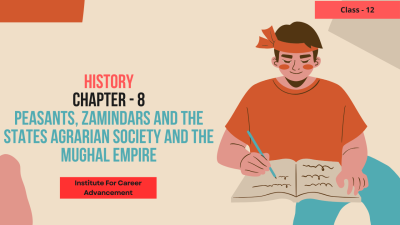Courses


 Compare
Compare
Framing of the Constitution: The Beginning of a New Era is a Class 12 chapter that likely explores the process of drafting and adopting the Indian Constitution, the founding principles that shaped it, and its significance as a milestone in India's history. It might delve into topics such as: Constituent Assembly: The formation and composition of the Constituent Assembly, the body responsible for drafting the Constitution. Founding Principles: The key principles that guided the drafting of the Constitution, including secularism, democracy, socialism, and justice. Key Features of the Constitution: The major provisions of the Constitution, such as the preamble, fundamental rights, fundamental duties, and the structure of government. Challenges and Debates: The challenges and debates that arose during the drafting process, including issues related to federalism, language, and social justice. Significance of the Constitution: The significance of the Indian Constitution as a landmark document in India's history and its role in shaping the nation's democratic values and institutions. Overall, this chapter likely provides a comprehensive overview of the process of framing the Indian Constitution, the key principles that underpin it, and its enduring significance as a foundation for Indian democracy. সংবিধানের গঠনঃ নতুন যুগের সূচনা হল দ্বাদশ শ্রেণির একটি অধ্যায় যা সম্ভবত ভারতীয় সংবিধানের খসড়া তৈরি ও গ্রহণের প্রক্রিয়া, যে প্রতিষ্ঠাতা নীতিগুলি এটিকে রূপ দিয়েছে এবং ভারতের ইতিহাসে একটি মাইলফলক হিসাবে এর তাৎপর্য অন্বেষণ করে। এটি নিম্নলিখিত বিষয়গুলি নিয়ে আলোচনা করতে পারেঃ গণপরিষদঃ গণপরিষদের গঠন ও গঠন, সংবিধানের খসড়া প্রণয়নের জন্য দায়ী সংস্থা। প্রতিষ্ঠার মূলনীতিঃ ধর্মনিরপেক্ষতা, গণতন্ত্র, সমাজতন্ত্র এবং ন্যায়বিচার সহ সংবিধানের খসড়া প্রণয়নের মূল নীতিগুলি। সংবিধানের প্রধান বৈশিষ্ট্যঃ সংবিধানের প্রধান বিধানগুলি, যেমন প্রস্তাবনা, মৌলিক অধিকার, মৌলিক কর্তব্য এবং সরকারের কাঠামো। চ্যালেঞ্জ এবং বিতর্কঃ ফেডারেলিজম, ভাষা এবং সামাজিক ন্যায়বিচার সম্পর্কিত বিষয়গুলি সহ খসড়া প্রক্রিয়া চলাকালীন উত্থাপিত চ্যালেঞ্জ এবং বিতর্ক। সংবিধানের তাৎপর্যঃ ভারতের ইতিহাসে একটি যুগান্তকারী দলিল হিসাবে ভারতীয় সংবিধানের তাৎপর্য এবং দেশের গণতান্ত্রিক মূল্যবোধ ও প্রতিষ্ঠান গঠনে এর ভূমিকা। সামগ্রিকভাবে, এই অধ্যায়টি সম্ভবত ভারতীয় সংবিধান প্রণয়নের প্রক্রিয়া, এর মূল নীতিগুলি এবং ভারতীয় গণতন্ত্রের ভিত্তি হিসাবে এর স্থায়ী তাৎপর্য সম্পর্কে একটি বিস্তৃত বিবরণ প্রদান করে।
0 Lessons
Hours

 Compare
Compare
Mahatma Gandhi and the National Movement: Civil Disobedience and Beyond is a Class 12 chapter that likely explores the role of Mahatma Gandhi in India's struggle for independence and his philosophy of nonviolent resistance. It might delve into topics such as: Gandhi's Early Life and Career: Gandhi's upbringing, education, and early experiences in South Africa, which shaped his political and social philosophy. Return to India and the National Movement: Gandhi's return to India and his involvement in the Indian National Congress, his adoption of the strategy of satyagraha (truth force), and his leadership of the national movement. Civil Disobedience Movements: The major civil disobedience campaigns led by Gandhi, including the Non-Cooperation Movement, the Salt March, and the Quit India Movement. Gandhi's Philosophy and Ideology: Gandhi's ideas on nonviolence, truth, and social justice, as well as his critique of Western civilization and his vision for an independent India. Legacy of Gandhi: Gandhi's impact on the Indian independence movement, his influence on global movements for peace and justice, and his continuing relevance in contemporary society. Overall, this chapter likely provides a comprehensive overview of Mahatma Gandhi's life, his contributions to the Indian independence movement, and his enduring legacy. মহাত্মা গান্ধী অ্যান্ড দ্য ন্যাশনাল মুভমেন্টঃ সিভিল ডিসওবিডেন্স অ্যান্ড বিয়ন্ড একটি দ্বাদশ শ্রেণির অধ্যায় যা সম্ভবত ভারতের স্বাধীনতা সংগ্রামে মহাত্মা গান্ধীর ভূমিকা এবং তাঁর অহিংস প্রতিরোধের দর্শনের অন্বেষণ করে। এটি নিম্নলিখিত বিষয়গুলি নিয়ে আলোচনা করতে পারেঃ গান্ধীর প্রাথমিক জীবন ও কর্মজীবনঃ গান্ধীর লালন-পালন, শিক্ষা এবং দক্ষিণ আফ্রিকায় প্রাথমিক অভিজ্ঞতা, যা তাঁর রাজনৈতিক ও সামাজিক দর্শনকে রূপ দিয়েছে। ভারতে ফিরে আসা এবং জাতীয় আন্দোলনঃ গান্ধীর ভারতে প্রত্যাবর্তন এবং ভারতীয় জাতীয় কংগ্রেসে তাঁর অংশগ্রহণ, সত্যাগ্রহ (সত্য শক্তি) কৌশল গ্রহণ এবং জাতীয় আন্দোলনে তাঁর নেতৃত্ব। আইন অমান্য আন্দোলনঃ অসহযোগ আন্দোলন, লবণ মিছিল এবং ভারত ছাড়ো আন্দোলন সহ গান্ধীর নেতৃত্বে প্রধান আইন অমান্য অভিযান। গান্ধীর দর্শন ও মতাদর্শঃ অহিংসা, সত্য এবং সামাজিক ন্যায়বিচারের উপর গান্ধীর ধারণাগুলি, পাশাপাশি পশ্চিমা সভ্যতা এবং একটি স্বাধীন ভারতের জন্য তাঁর দৃষ্টিভঙ্গির সমালোচনা। গান্ধীর উত্তরাধিকারঃ ভারতীয় স্বাধীনতা আন্দোলনে গান্ধীর প্রভাব, শান্তি ও ন্যায়বিচারের জন্য বিশ্বব্যাপী আন্দোলনে তাঁর প্রভাব এবং সমসাময়িক সমাজে তাঁর অব্যাহত প্রাসঙ্গিকতা। সামগ্রিকভাবে, এই অধ্যায়টি সম্ভবত মহাত্মা গান্ধীর জীবন, ভারতীয় স্বাধীনতা আন্দোলনে তাঁর অবদান এবং তাঁর স্থায়ী উত্তরাধিকার সম্পর্কে একটি বিস্তৃত বিবরণ প্রদান করে।
0 Lessons
Hours

 Compare
Compare
Rebels and Raj: 1857 Revolt and Its Representations is a Class 12 chapter that likely explores the 1857 Revolt against British colonial rule in India and the various ways in which it has been portrayed and interpreted. It might delve into topics such as: Causes and Outbreak: The factors that led to the 1857 Revolt, including economic grievances, cultural and religious tensions, and military discontent. Key Events and Figures: The major events and personalities associated with the Revolt, including the role of sepoys, princes, and religious leaders. British Response and Suppression: The British government's response to the Revolt, including military actions, political reforms, and the reassertion of colonial authority. Representations in Literature and Art: The ways in which the Revolt has been depicted in literature, art, and other cultural forms, including its portrayal as a struggle for independence, a religious uprising, or a social rebellion. Historical Interpretations: The different historical interpretations of the Revolt, including nationalist, colonial, and Marxist perspectives. Overall, this chapter likely provides a comprehensive overview of the 1857 Revolt, its significance in Indian history, and the ways in which it has been remembered and understood. বিদ্রোহী এবং রাজঃ 1857 বিদ্রোহ এবং এর প্রতিনিধিত্ব একটি দ্বাদশ শ্রেণির অধ্যায় যা সম্ভবত ভারতে ব্রিটিশ ঔপনিবেশিক শাসনের বিরুদ্ধে 1857 সালের বিদ্রোহ এবং বিভিন্ন উপায়ে এটি চিত্রিত ও ব্যাখ্যা করা হয়েছে। এটি নিম্নলিখিত বিষয়গুলি নিয়ে আলোচনা করতে পারেঃ কারণ এবং প্রাদুর্ভাবঃ অর্থনৈতিক অভিযোগ, সাংস্কৃতিক ও ধর্মীয় উত্তেজনা এবং সামরিক অসন্তোষ সহ 1857 সালের বিদ্রোহের কারণগুলি। মূল ঘটনা ও পরিসংখ্যানঃ সিপাহী, রাজকুমার এবং ধর্মীয় নেতাদের ভূমিকা সহ বিদ্রোহের সাথে যুক্ত প্রধান ঘটনা এবং ব্যক্তিত্ব। ব্রিটিশ প্রতিক্রিয়া ও দমনঃ সামরিক পদক্ষেপ, রাজনৈতিক সংস্কার এবং ঔপনিবেশিক কর্তৃত্বের পুনর্বিবেচনা সহ বিদ্রোহের প্রতি ব্রিটিশ সরকারের প্রতিক্রিয়া। সাহিত্য ও শিল্পে প্রতিনিধিত্বঃ স্বাধীনতা সংগ্রাম, ধর্মীয় বিদ্রোহ বা সামাজিক বিদ্রোহ হিসাবে এর চিত্র সহ সাহিত্য, শিল্প এবং অন্যান্য সাংস্কৃতিক রূপগুলিতে বিদ্রোহকে যেভাবে চিত্রিত করা হয়েছে। ঐতিহাসিক ব্যাখ্যাঃ জাতীয়তাবাদী, ঔপনিবেশিক এবং মার্কসবাদী দৃষ্টিভঙ্গি সহ বিদ্রোহের বিভিন্ন ঐতিহাসিক ব্যাখ্যা। সামগ্রিকভাবে, এই অধ্যায়টি সম্ভবত 1857 সালের বিদ্রোহ, ভারতীয় ইতিহাসে এর তাৎপর্য এবং কীভাবে এটি স্মরণ ও বোঝা হয়েছে তার একটি বিস্তৃত বিবরণ প্রদান করে।
0 Lessons
Hours

 Compare
Compare
Colonialism and the Countryside: Exploring Official Archives is a Class 12 chapter that likely delves into the impact of British colonialism on rural India, focusing on the analysis of official archives. It might explore topics such as: British Colonial Policies: The land reforms, revenue systems, and administrative structures implemented by the British in rural India. Official Archives: The nature and content of official archives, including land records, revenue records, and administrative reports. Analyzing Archival Sources: The methods and techniques used to analyze archival sources, including critical reading, interpretation, and contextualization. Impact of Colonialism on Rural Life: The social, economic, and cultural changes brought about by British colonialism in rural areas, such as land alienation, forced labor, and changes in agricultural practices. Resistance and Adaptation: The ways in which rural communities resisted or adapted to British colonial rule, including forms of protest, cultural preservation, and economic strategies. Overall, this chapter likely provides a comprehensive overview of the impact of British colonialism on rural India, using official archives as a primary source of evidence. It offers insights into the social, economic, and cultural changes that occurred during this period, as well as the ways in which rural communities responded to colonial rule. উপনিবেশবাদ এবং গ্রামাঞ্চলঃ অফিসিয়াল আর্কাইভ অন্বেষণ এটি দ্বাদশ শ্রেণির একটি অধ্যায় যা সম্ভবত গ্রামীণ ভারতে ব্রিটিশ উপনিবেশবাদের প্রভাবের উপর আলোকপাত করে, সরকারী সংরক্ষণাগারগুলির বিশ্লেষণের উপর দৃষ্টি নিবদ্ধ করে। এটি নিম্নলিখিত বিষয়গুলি অন্বেষণ করতে পারেঃ ব্রিটিশ ঔপনিবেশিক নীতিঃ গ্রামীণ ভারতে ব্রিটিশদের দ্বারা বাস্তবায়িত ভূমি সংস্কার, রাজস্ব ব্যবস্থা এবং প্রশাসনিক কাঠামো। অফিসিয়াল আর্কাইভসঃ ভূমি রেকর্ড, রাজস্ব রেকর্ড এবং প্রশাসনিক প্রতিবেদন সহ অফিসিয়াল আর্কাইভের প্রকৃতি এবং বিষয়বস্তু। সংরক্ষণাগার উৎস বিশ্লেষণঃ সমালোচনামূলক পাঠ, ব্যাখ্যা এবং প্রাসঙ্গিককরণ সহ সংরক্ষণাগার উৎস বিশ্লেষণের জন্য ব্যবহৃত পদ্ধতি এবং কৌশল। গ্রামীণ জীবনে উপনিবেশবাদের প্রভাবঃ গ্রামাঞ্চলে ব্রিটিশ উপনিবেশবাদ দ্বারা আনা সামাজিক, অর্থনৈতিক ও সাংস্কৃতিক পরিবর্তন, যেমন ভূমি বিচ্ছিন্নতা, জোরপূর্বক শ্রম এবং কৃষি পদ্ধতিতে পরিবর্তন। প্রতিরোধ ও অভিযোজনঃ প্রতিবাদ, সাংস্কৃতিক সংরক্ষণ এবং অর্থনৈতিক কৌশল সহ গ্রামীণ সম্প্রদায়গুলি যেভাবে ব্রিটিশ ঔপনিবেশিক শাসনের বিরোধিতা করেছিল বা মানিয়ে নিয়েছিল। সামগ্রিকভাবে, এই অধ্যায়টি সম্ভবত গ্রামীণ ভারতে ব্রিটিশ উপনিবেশবাদের প্রভাবের একটি বিস্তৃত পর্যালোচনা প্রদান করে, সরকারী সংরক্ষণাগারগুলিকে প্রমাণের প্রাথমিক উৎস হিসাবে ব্যবহার করে। এটি এই সময়কালে ঘটে যাওয়া সামাজিক, অর্থনৈতিক এবং সাংস্কৃতিক পরিবর্তনের পাশাপাশি গ্রামীণ সম্প্রদায়গুলি ঔপনিবেশিক শাসনের প্রতি কীভাবে প্রতিক্রিয়া জানিয়েছিল সে সম্পর্কে অন্তর্দৃষ্টি প্রদান করে।
0 Lessons
Hours

 Compare
Compare
Peasants, Zamindars, and the States: Agrarian Society and the Mughal Empire is a Class 12 chapter that likely explores the agrarian structure of the Mughal Empire and the relationship between peasants, zamindars, and the state. It might delve into topics such as: Land Ownership and Revenue Systems: The different land ownership systems and revenue collection methods employed by the Mughals, including the zamindari system and the ryotwari system. The Role of Peasants: The lives and experiences of peasants, their rights and responsibilities, and the challenges they faced in providing for themselves and their families. The Power of Zamindars: The role of zamindars as intermediaries between the state and the peasants, their power and influence, and the ways in which they could exploit the peasantry. State Policies and Agrarian Reforms: The Mughal Empire's agrarian policies, including land reforms, revenue reforms, and measures to protect the peasantry. Social and Economic Conditions: The social and economic conditions of the peasantry, including their standard of living, access to resources, and vulnerability to exploitation. Overall, this chapter likely provides a comprehensive overview of the agrarian society of the Mughal Empire, the relationships between different social groups, and the challenges and opportunities faced by the peasantry. কৃষক, জমিদার এবং রাজ্যঃ কৃষি সমাজ এবং মুঘল সাম্রাজ্য দ্বাদশ শ্রেণির একটি অধ্যায় যা সম্ভবত মুঘল সাম্রাজ্যের কৃষি কাঠামো এবং কৃষক, জমিদার এবং রাষ্ট্রের মধ্যে সম্পর্কের অন্বেষণ করে। এটি নিম্নলিখিত বিষয়গুলি নিয়ে আলোচনা করতে পারেঃ জমির মালিকানা এবং রাজস্ব ব্যবস্থাঃ জমিদারি ব্যবস্থা এবং রায়তওয়ারি ব্যবস্থা সহ মুঘলদের দ্বারা ব্যবহৃত বিভিন্ন ভূমি মালিকানা ব্যবস্থা এবং রাজস্ব সংগ্রহের পদ্ধতি। কৃষকদের ভূমিকাঃ কৃষকদের জীবন ও অভিজ্ঞতা, তাদের অধিকার ও দায়িত্ব এবং নিজেদের এবং তাদের পরিবারের জন্য সরবরাহ করার ক্ষেত্রে তারা যে চ্যালেঞ্জগুলির মুখোমুখি হয়েছিল। জমিদারদের শক্তিঃ রাষ্ট্র ও কৃষকদের মধ্যে মধ্যস্থতাকারী হিসাবে জমিদারদের ভূমিকা, তাদের ক্ষমতা ও প্রভাব এবং কীভাবে তারা কৃষকদের শোষণ করতে পারে। রাজ্য নীতি ও কৃষি সংস্কারঃ মুঘল সাম্রাজ্যের কৃষি নীতি, যার মধ্যে রয়েছে ভূমি সংস্কার, রাজস্ব সংস্কার এবং কৃষকদের সুরক্ষার ব্যবস্থা। সামাজিক ও অর্থনৈতিক অবস্থাঃ কৃষকদের সামাজিক ও অর্থনৈতিক অবস্থা, যার মধ্যে তাদের জীবনযাত্রার মান, সম্পদের অ্যাক্সেস এবং শোষণের দুর্বলতা রয়েছে। সামগ্রিকভাবে, এই অধ্যায়টি সম্ভবত মুঘল সাম্রাজ্যের কৃষিভিত্তিক সমাজ, বিভিন্ন সামাজিক গোষ্ঠীর মধ্যে সম্পর্ক এবং কৃষকদের সম্মুখীন হওয়া চ্যালেঞ্জ ও সুযোগগুলির একটি বিস্তৃত বিবরণ প্রদান করে।
0 Lessons
Hours

 Compare
Compare
An Imperial Capital: Vijayanagar is a Class 12 chapter that likely explores the history, culture, and architecture of the Vijayanagar Empire, one of the most powerful and influential kingdoms in medieval South India. It might delve into topics such as: The Rise of Vijayanagar: The factors that led to the establishment of the Vijayanagar Empire, its founding rulers, and its expansion. The Vijayanagar Capital: The planning, construction, and architectural features of the Vijayanagar capital, Hampi, which is now a UNESCO World Heritage Site. Economic Prosperity: The Vijayanagar Empire's economic activities, including trade, agriculture, and mining, which contributed to its wealth and power. Cultural Achievements: The Vijayanagar Empire's contributions to art, literature, music, and architecture, reflecting the vibrant and cosmopolitan nature of the kingdom. Religious Tolerance: The Vijayanagar Empire's policy of religious tolerance, which fostered a diverse and multicultural society. Decline and Fall: The factors that led to the decline and eventual fall of the Vijayanagar Empire, including internal conflicts, invasions, and economic difficulties. Overall, this chapter likely provides a comprehensive overview of the Vijayanagar Empire, its historical significance, and its lasting legacy. একটি রাজকীয় রাজধানীঃ বিজয়নগর দ্বাদশ শ্রেণির একটি অধ্যায় যা সম্ভবত মধ্যযুগীয় দক্ষিণ ভারতের অন্যতম শক্তিশালী এবং প্রভাবশালী রাজ্য বিজয়নগর সাম্রাজ্যের ইতিহাস, সংস্কৃতি এবং স্থাপত্যের অন্বেষণ করে। এটি নিম্নলিখিত বিষয়গুলি নিয়ে আলোচনা করতে পারেঃ বিজয়নগরের উত্থানঃ বিজয়নগর সাম্রাজ্যের প্রতিষ্ঠা, এর প্রতিষ্ঠাতা শাসক এবং এর সম্প্রসারণের কারণগুলি। বিজয়নগর রাজধানীঃ বিজয়নগরের রাজধানী হাম্পির পরিকল্পনা, নির্মাণ এবং স্থাপত্য বৈশিষ্ট্য, যা এখন ইউনেস্কোর বিশ্ব ঐতিহ্যবাহী স্থান। অর্থনৈতিক সমৃদ্ধিঃ বিজয়নগর সাম্রাজ্যের বাণিজ্য, কৃষি ও খনি সহ অর্থনৈতিক কার্যক্রম, যা এর সম্পদ ও শক্তিতে অবদান রেখেছিল। সাংস্কৃতিক সাফল্যঃ শিল্প, সাহিত্য, সঙ্গীত এবং স্থাপত্যের ক্ষেত্রে বিজয়নগর সাম্রাজ্যের অবদান রাজ্যের প্রাণবন্ত এবং বিশ্বজনীন প্রকৃতিকে প্রতিফলিত করে। ধর্মীয় সহনশীলতাঃ বিজয়নগর সাম্রাজ্যের ধর্মীয় সহনশীলতার নীতি, যা একটি বৈচিত্র্যময় এবং বহুসংস্কৃতির সমাজকে উৎসাহিত করেছিল। পতন এবং পতনঃ অভ্যন্তরীণ দ্বন্দ্ব, আক্রমণ এবং অর্থনৈতিক সমস্যা সহ বিজয়নগর সাম্রাজ্যের পতন এবং শেষ পর্যন্ত পতনের কারণগুলি। সামগ্রিকভাবে, এই অধ্যায়টি সম্ভবত বিজয়নগর সাম্রাজ্য, এর ঐতিহাসিক তাৎপর্য এবং এর স্থায়ী উত্তরাধিকার সম্পর্কে একটি বিস্তৃত বিবরণ প্রদান করে।
0 Lessons
Hours

 Compare
Compare
Bhakti-Sufi Traditions: Changes in Religious Beliefs and Devotional Texts is a Class 12 chapter that likely explores the development and influence of Bhakti and Sufi traditions in India. It might delve into topics such as: Bhakti Movement: The rise of the Bhakti movement, its key figures (like Ramananda, Kabir, and Tukaram), and its emphasis on devotion and love for God. Sufism: The mystical branch of Islam, its key figures (like Al-Hallaj and Rumi), and its emphasis on spiritual enlightenment and union with God. Synthesis of Traditions: The ways in which Bhakti and Sufi traditions interacted and influenced each other, leading to the synthesis of Hindu and Islamic ideas. Devotional Texts: The development of new devotional texts, including poetry, songs, and hymns, that expressed the Bhakti and Sufi ideals. Social and Cultural Impact: The impact of Bhakti and Sufi traditions on Indian society and culture, including changes in religious practices, social hierarchies, and artistic expressions. Overall, this chapter likely provides a comprehensive overview of the Bhakti and Sufi traditions, their contributions to Indian religious thought, and their influence on the social and cultural landscape of the region. ভক্তি-সুফি ঐতিহ্যঃ ধর্মীয় বিশ্বাস ও ভক্তিমূলক গ্রন্থে পরিবর্তন হল দ্বাদশ শ্রেণির একটি অধ্যায় যা সম্ভবত ভারতে ভক্তি ও সুফি ঐতিহ্যের বিকাশ ও প্রভাব অন্বেষণ করে। এটি নিম্নলিখিত বিষয়গুলি নিয়ে আলোচনা করতে পারেঃ ভক্তি আন্দোলনঃ ভক্তি আন্দোলনের উত্থান, এর মূল ব্যক্তিত্ব (যেমন রামানন্দ, কবির এবং তুকারাম) এবং ঈশ্বরের প্রতি ভক্তি ও ভালবাসার উপর জোর দেওয়া। সুফিবাদঃ ইসলামের রহস্যময় শাখা, এর মূল ব্যক্তিত্ব (যেমন আল-হাল্লাজ এবং রুমি) এবং আধ্যাত্মিক জ্ঞান এবং ঈশ্বরের সাথে মিলনের উপর জোর দেওয়া। ঐতিহ্যের সংশ্লেষঃ ভক্তি এবং সুফি ঐতিহ্যগুলি যেভাবে একে অপরের সাথে মিথস্ক্রিয়া করে এবং একে অপরকে প্রভাবিত করে, যা হিন্দু ও ইসলামী ধারণার সংশ্লেষণের দিকে পরিচালিত করে। ভক্তিমূলক গ্রন্থঃ কবিতা, গান এবং স্তব সহ নতুন ভক্তিমূলক গ্রন্থের বিকাশ, যা ভক্তি এবং সুফি আদর্শকে প্রকাশ করে। সামাজিক ও সাংস্কৃতিক প্রভাবঃ ধর্মীয় অনুশীলন, সামাজিক শ্রেণিবিন্যাস এবং শৈল্পিক অভিব্যক্তির পরিবর্তন সহ ভারতীয় সমাজ ও সংস্কৃতিতে ভক্তি ও সুফি ঐতিহ্যের প্রভাব। সামগ্রিকভাবে, এই অধ্যায়টি সম্ভবত ভক্তি ও সুফি ঐতিহ্য, ভারতীয় ধর্মীয় চিন্তায় তাদের অবদান এবং এই অঞ্চলের সামাজিক ও সাংস্কৃতিক প্রেক্ষাপটে তাদের প্রভাব সম্পর্কে একটি বিস্তৃত বিবরণ প্রদান করে।
0 Lessons
Hours

 Compare
Compare
Through the Eyes of Travelers: Perceptions of Society is a Class 12 chapter that likely explores the perspectives and observations of foreign travelers who visited ancient civilizations. It might delve into topics such as: Travel Accounts: The experiences and observations of travelers, including their impressions of the people, customs, and landscapes they encountered. Cultural Exchanges: The ways in which travelers interacted with local populations, exchanged goods and ideas, and contributed to cultural diffusion. Perceptions of Foreigners: The ways in which local people viewed and responded to foreign travelers, including stereotypes, prejudices, and curiosity. The Impact of Travel: The influence of travel on the development of civilizations, including the introduction of new technologies, ideas, and practices. Overall, this chapter likely provides a unique perspective on ancient civilizations by examining them through the eyes of outsiders. It offers insights into cultural exchanges, perceptions, and the impact of foreign contact. ভ্রমণকারীদের চোখের মাধ্যমেঃ সমাজের উপলব্ধি একটি দ্বাদশ শ্রেণির অধ্যায় যা সম্ভবত প্রাচীন সভ্যতা পরিদর্শনকারী বিদেশী ভ্রমণকারীদের দৃষ্টিভঙ্গি এবং পর্যবেক্ষণগুলি অন্বেষণ করে। এটি নিম্নলিখিত বিষয়গুলি নিয়ে আলোচনা করতে পারেঃ ভ্রমণ বিবরণীঃ ভ্রমণকারীদের অভিজ্ঞতা এবং পর্যবেক্ষণ, যার মধ্যে রয়েছে মানুষ, রীতিনীতি এবং প্রাকৃতিক দৃশ্যের প্রতি তাদের অনুভূতি। সাংস্কৃতিক বিনিময়ঃ ভ্রমণকারীরা যেভাবে স্থানীয় জনগণের সঙ্গে ভাববিনিময় করেন, পণ্য ও ধারণা বিনিময় করেন এবং সাংস্কৃতিক প্রসারে অবদান রাখেন। বিদেশীদের উপলব্ধিঃ স্থানীয় লোকেরা যেভাবে বিদেশী ভ্রমণকারীদের প্রতি দৃষ্টিভঙ্গি, কুসংস্কার এবং কৌতূহল সহ প্রতিক্রিয়া দেখায়। ভ্রমণের প্রভাবঃ নতুন প্রযুক্তি, ধারণা এবং অনুশীলনের প্রবর্তন সহ সভ্যতার বিকাশে ভ্রমণের প্রভাব। সামগ্রিকভাবে, এই অধ্যায়টি সম্ভবত বহিরাগতদের দৃষ্টিতে পরীক্ষা করে প্রাচীন সভ্যতার উপর একটি অনন্য দৃষ্টিভঙ্গি প্রদান করে। এটি সাংস্কৃতিক বিনিময়, উপলব্ধি এবং বিদেশী যোগাযোগের প্রভাব সম্পর্কে অন্তর্দৃষ্টি প্রদান করে।
0 Lessons
Hours

 Compare
Compare
Thinkers, Beliefs, and Buildings: Cultural Developments is a Class 12 chapter that likely explores the intellectual, religious, and artistic aspects of ancient civilizations. It might delve into topics such as: Philosophical and Religious Thought: The ideas and beliefs of prominent thinkers and philosophers, the development of major religions, and the impact of these beliefs on society. Architectural Marvels: The construction techniques, purpose, and significance of iconic buildings and structures in ancient civilizations. Artistic Expressions: The different forms of art, such as painting, sculpture, and literature, and their cultural significance. Scientific Discoveries: The contributions of ancient civilizations to fields like astronomy, mathematics, and medicine. Cultural Exchange and Diffusion: The ways in which ideas, beliefs, and practices were shared and adopted by different civilizations. Overall, this chapter likely provides a comprehensive overview of the cultural achievements of ancient civilizations, setting the stage for understanding the subsequent development of art, philosophy, religion, and science. চিন্তাবিদ, বিশ্বাস এবং ভবনঃ সাংস্কৃতিক উন্নয়ন হল দ্বাদশ শ্রেণির একটি অধ্যায় যা সম্ভবত প্রাচীন সভ্যতার বুদ্ধিবৃত্তিক, ধর্মীয় এবং শৈল্পিক দিকগুলি অন্বেষণ করে। এটি নিম্নলিখিত বিষয়গুলি নিয়ে আলোচনা করতে পারেঃ দার্শনিক ও ধর্মীয় চিন্তাঃ বিশিষ্ট চিন্তাবিদ ও দার্শনিকদের ধারণা ও বিশ্বাস, প্রধান ধর্মগুলির বিকাশ এবং সমাজে এই বিশ্বাসগুলির প্রভাব। আর্কিটেকচারাল মার্ভেলসঃ প্রাচীন সভ্যতায় আইকনিক বিল্ডিং এবং কাঠামোর নির্মাণ কৌশল, উদ্দেশ্য এবং তাৎপর্য। শৈল্পিক অভিব্যক্তিঃ শিল্পের বিভিন্ন রূপ, যেমন চিত্রকলা, ভাস্কর্য এবং সাহিত্য এবং তাদের সাংস্কৃতিক তাৎপর্য। বৈজ্ঞানিক আবিষ্কারঃ জ্যোতির্বিজ্ঞান, গণিত এবং ওষুধের মতো ক্ষেত্রে প্রাচীন সভ্যতার অবদান। সাংস্কৃতিক বিনিময় এবং বিস্তারঃ বিভিন্ন সভ্যতার মধ্যে ধারণাগুলি, বিশ্বাস এবং অনুশীলনগুলি ভাগ করে নেওয়ার এবং গ্রহণ করার উপায়গুলি। সামগ্রিকভাবে, এই অধ্যায়টি সম্ভবত প্রাচীন সভ্যতার সাংস্কৃতিক সাফল্যের একটি বিস্তৃত বিবরণ প্রদান করে, যা শিল্প, দর্শন, ধর্ম এবং বিজ্ঞানের পরবর্তী বিকাশ বোঝার জন্য মঞ্চ তৈরি করে।
0 Lessons
Hours